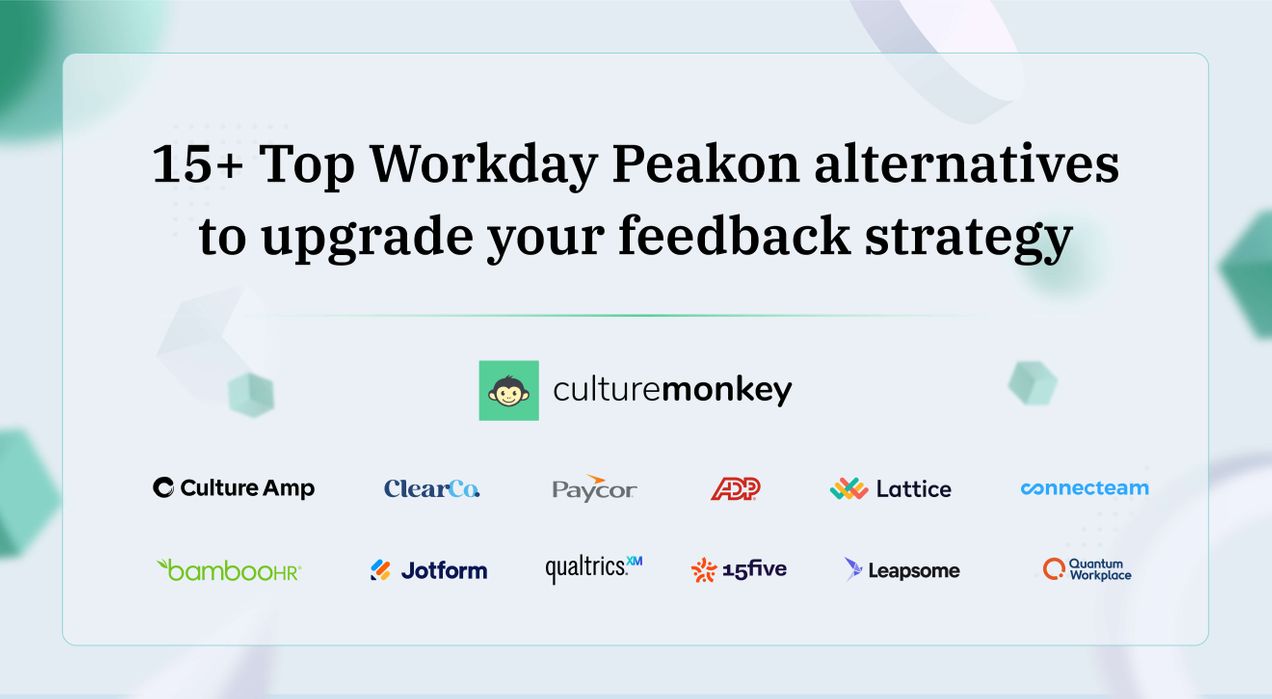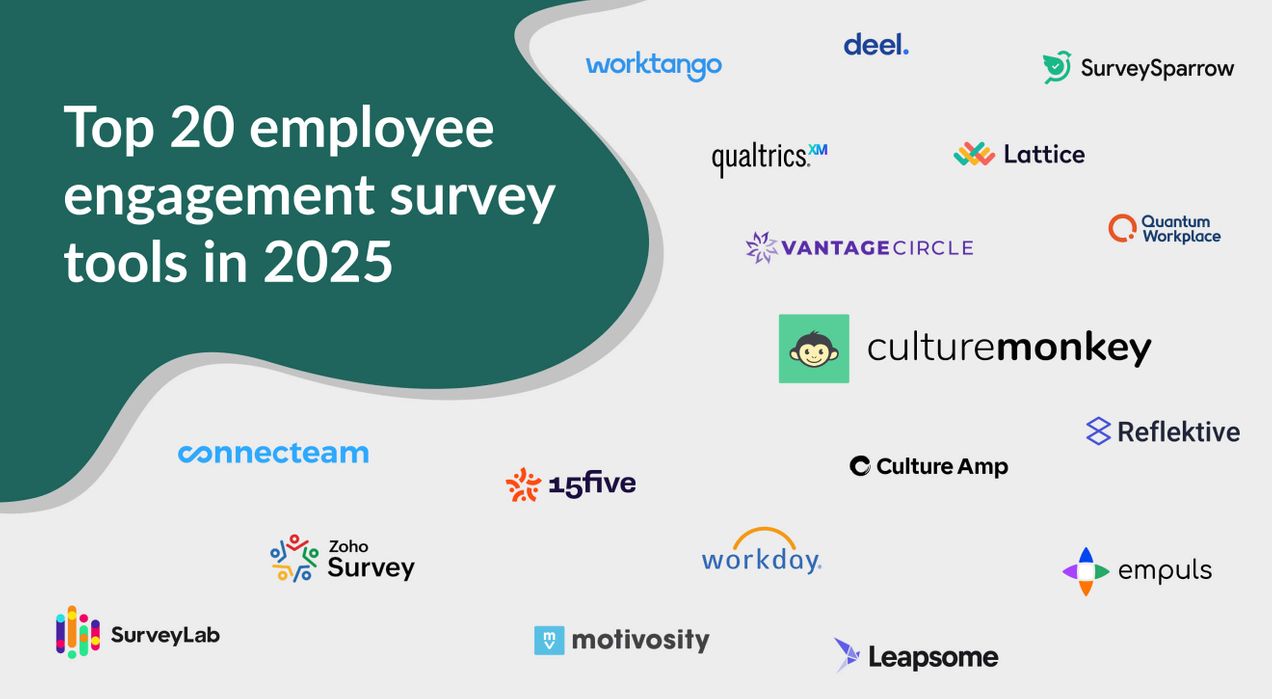Employee satisfaction survey form: Perfect questionnaire to know your people in 2026

Remember those school report cards where one teacher always scribbled, “Shows promise but needs to participate more”? You probably dreaded reading it but it told you something real. It wasn’t about punishment; it was feedback meant to help you grow.
An employee satisfaction survey form works the same way. It’s not just a corporate checkbox—it’s your organization’s report card from the people who know it best. Done right, it doesn’t just measure satisfaction; it reveals patterns, blind spots, and moments that matter. It helps you see where your culture shines and where it could use a little extra care.
Think of it as your grown-up version of that teacher’s note—only now, you’re the one deciding how to turn that feedback into action. Let’s unpack how to make every response truly count.
- Employee satisfaction survey forms uncover hidden truths about how your people truly feel at work daily.
- A simple change from survey feedback, like adding brainstorming sessions, can massively boost morale and team collaboration.
- When employees feel genuinely heard, excitement replaces burnout, and productivity and engagement levels skyrocket consistently.
- The right survey questions don’t just gather data; they spark meaningful cultural and organizational transformation across teams.
- In 2026, building a smart employee satisfaction survey form is your golden ticket to happier employees and stronger sustainable business results.
What is an employee satisfaction survey form?

An employee satisfaction survey form is like a mirror for your workplace—reflecting morale, engagement, and job satisfaction honestly.
It helps HR professionals and leaders turn raw employee feedback into smarter decisions that boost employee engagement and retention.
An employee satisfaction survey is a structured employee survey designed to capture how employees really feel about their work environment, leadership, and growth opportunities. It covers everything from job satisfaction and employee morale to management effectiveness and cultural alignment.
For HR professionals, it gives them the pulse of the organization, highlighting hidden challenges that might otherwise fester burnout, low morale, disengagement, or communication gaps. Employees feel valued when they’re asked for input, especially when that employee feedback translates into real change.
Employees speak up, and leaders listen, creating a loop that fuels higher employee engagement. Done right, an employee satisfaction survey form doesn’t just measure—it transforms workplaces into thriving, people-first cultures.
Now that you know what an employee satisfaction survey form is, let’s explore why it matters more than ever for organizations in 2026.
Why should companies use a satisfaction survey in 2026?

Workplaces today move at lightning speed, and assumptions about what keeps people happy are outdated. That’s why companies in 2026 need satisfaction surveys, not as paperwork, but as culture-changing tools.
Perks aren’t the full story
Imagine this: a buzzing startup with bean bags, free coffee, and a ping-pong table swears it has the “coolest culture in town.” But suddenly, a few star performers resign. The truth? What employees perceive about the workplace often differs from what management assumes. And that gap is where problems start.
Surveys make the invisible visible
A well-designed survey template helps measure employee satisfaction in ways perks never could. It uncovers valuable insights about recognition, leadership, growth, and communication. Instead of relying on guesswork, HR professionals get hard data on overall job satisfaction and morale—straight from the people who matter most.
Satisfied employees fuel success
Satisfied employees don’t just show up—they bring energy, innovation, and loyalty to the table. Acting on employee feedback builds trust, raises employee engagement, and reduces turnover. In short, listening pays dividends.
Why 2026 is the year of listening
The modern workplace is evolving fast, and assumptions won’t cut it anymore. Using an employee satisfaction survey form is like having a cheat code for culture—it reveals what’s working and what desperately needs a fix. Companies that tune in and act on this feedback will build workplaces where employees thrive, not just survive.
So once you’ve seen why surveys matter, the next question is how exactly does employee satisfaction translate into stronger engagement and retention?
How does employee satisfaction impact engagement and retention?

Employee satisfaction isn’t just a feel-good metric but it’s the secret ingredient that keeps people motivated, engaged, and loyal. When employees are truly satisfied, they don’t just stay; they flourish, innovate, and grow with the company.
The story behind satisfaction
An employee who once felt invisible finally gets meaningful career development opportunities and recognition for their contributions. Suddenly, their energy shifts—they’re more engaged, more confident, and they begin championing company culture. That transformation spreads across teams, boosting morale and performance.
Engagement thrives on satisfaction
Satisfied employees are more open to sharing honest feedback through pulse surveys, and when leaders prevent survey fatigue by keeping them concise and relevant, the insights become gold. Survey data highlights issues like work life balance and workplace culture, empowering HR professionals to create continuous improvement strategies that people actually care about.
Retention is the ultimate reward
When employees see clear paths for professional growth and career growth, their loyalty strengthens. Strong workplace culture built on action, not lip service, drives long-term employee retention. Satisfied employees don’t just stay—they become vocal advocates for the company.
The bigger picture
Employee satisfaction fuels engagement and retention by creating an environment where people feel valued, supported, and inspired. When satisfaction is nurtured, the workplace stops being just a paycheck and evolves into a community where employees genuinely want to belong.
We’ve seen how satisfaction fuels engagement, now let’s look at how to measure it properly by focusing on the key areas that truly matter.
What are the key areas to cover in a satisfaction survey?

A satisfaction survey isn’t just a checklist—it’s like tuning a guitar. Miss one string, and the whole melody is off. To truly measure job satisfaction, you need to strike the right notes across different areas of employee life.
Growth and professional development
Employees want more than paychecks—they crave learning and career growth. Questions about professional development help management teams understand whether staff feel supported in building new skills or stuck in career quicksand.
Work environment and job security
A great survey template digs into how secure employees feel in their roles and whether workplace issues are being addressed. When people constantly worry about job security, it’s hard to focus on engagement or personal life balance.
Leadership and direct reports
How employees view their managers shapes the entire culture. Smart employee survey templates should ask whether direct reports feel heard, respected, and guided effectively. A “strongly disagree” here is a red flag leaders can’t afford to ignore.
Work life balance and culture
Surveys must gather feedback on whether work is intruding into personal life. This is where survey results reveal if company culture supports balance or glorifies burnout. Addressing this is crucial for long-term retention.
Communication and feedback loops
Employees want channels where they can raise workplace issues and see action. Adding these questions ensures leaders don’t just listen but follow through. Done right, surveys uncover blind spots and inspire continuous improvement.
Once you know which areas to include, the next big question is, how many questions should your survey actually have? Let’s break that down.
What’s the ideal number of questions to ask?
Imagine walking into a restaurant and being handed a 20-page menu. Overwhelming, right? The same goes for surveys. Too many questions, and employees lose focus; too few, and you miss out on valuable insights. Striking the balance is what makes a successful organization stand out.
The goal isn’t to cover everything in one shot, but to design questions that capture the heart of employee experience. Ten to fifteen questions are usually ideal—they’re enough to measure employee sentiment, mental health, and engagement without causing fatigue.
And here’s where the fun comes in: not every survey has to dig into every workplace issue. Use follow up surveys or pulse checks for deeper dives into areas like training programs, career development, or leadership effectiveness. That way, you collect feedback without overwhelming employees.
Qualitative feedback also deserves a spot. Throw in one or two open-ended questions so employees can share stories or suggestions. Sometimes, a short paragraph of honest feedback reveals more than five multiple-choice responses combined.
Ultimately, designing the right number of questions is about respecting time, valuing input, and creating a rhythm. Keep it lean, keep it smart, and watch your survey results turn into real culture-shaping insights.
Knowing how long your survey should be is one thing but asking the right kind of questions is what makes your results meaningful.
How to ask questions that give honest and useful answers
Crafting the right questions helps identify areas where employees feel supported or stuck without sugarcoating the truth.
Simple, clear, and relatable questions uncover how people view team culture, career advancement, job performance, and company leadership.
Asking questions in a survey isn’t about ticking boxes—it’s about opening doors to honesty. If the questions are confusing, too formal, or feel like traps, employees shut down. But when questions are clear, relatable, and thoughtful, they unlock genuine stories that reveal how people really see fairness, leadership, culture, and growth.
Questions that uncover fairness
Start with fairness. A question like “Do you feel paid fairly for your work?” opens up insights into compensation without making it awkward. Pair that with prompts about career advancement and performance evaluations to identify areas where growth feels possible—or blocked.
Questions that reflect culture
Next, dive into culture. Asking about team culture or organizational culture highlights whether collaboration is thriving or if silos are quietly strangling communication. These insights directly tie to improved productivity and overall morale.
(Source: The Conference Board, 2025)
Questions about leadership
Leadership matters too. Questions about company leadership should avoid jargon and instead ask how approachable, supportive, and transparent managers feel. When employees answer honestly, leaders gain a mirror to reflect on their impact.
Mixing structure with flexibility
Finally, balance structure with flexibility. Use rating scales to track trends in job performance, but always leave room for open-ended responses. That’s where the raw, unfiltered stories surface.
But even the smartest questions won’t help if you’re measuring the wrong thing. Let’s decode how satisfaction surveys differ from engagement surveys and why you need both.
What’s the difference between a satisfaction survey and an engagement survey?

Surveys often get lumped into one big bucket, but there’s a world of difference between a satisfaction survey and an engagement survey. Think of it as the difference between asking, “Are you happy here?” versus “Will you go the extra mile with us?” Both matter—but for very different reasons.
Satisfaction surveys focus on contentment
Imagine an employee who enjoys their pay, likes their desk setup, and feels their workload is manageable. A satisfaction survey captures these honest opinions—covering basics like whether employees feel appreciated, supported, and secure. It’s a snapshot of job contentment and overall morale, and it helps team leaders identify areas where small changes could boost daily experiences.
Engagement surveys measure commitment
Now flip the story. Another employee isn’t just content; they’re energized, driven, and ready to champion the company’s mission. An engagement survey digs into this mindset, asking whether employees feel empowered, inspired by the leadership team, and motivated to contribute beyond the bare minimum.
Why both matter
While satisfaction surveys highlight comfort and stability, engagement surveys offer valuable insights into passion, drive, and alignment with organizational culture. For an organization’s success, you can’t have one without the other. Employees may be satisfied but not engaged—or engaged but unsatisfied. Smart HR professionals use both tools together, ensuring the leadership team can act on feedback that builds not only happy employees but also a workforce committed to pushing the organization forward.
Once you understand the difference, timing becomes your next secret weapon, let’s see when to send your survey for the most authentic feedback.
When should you send a satisfaction survey to employees?

Timing is everything. Imagine throwing a party and asking guests for feedback halfway through the first song—it’s too early. Wait until the end, and you’ve lost your chance to fix the playlist. The same logic applies to a satisfaction survey. Send it at the right moment, and you’ll capture honest, useful insights.
For new hires, using a job satisfaction questionnaire template around the three-month mark works wonders. By then, they’ve settled into routines, interacted with the team, and can give meaningful input through an employee feedback form. It’s the sweet spot between “too new to judge” and “already disengaged.”
For long-term staff, organizations often use a staff satisfaction survey format every six or twelve months. Regular intervals keep the feedback loop fresh while avoiding survey fatigue. And if anonymity is a concern, an anonymous employee satisfaction form encourages candid responses that employees might hesitate to share openly.
Special moments matter too. After rolling out big changes—say, a new HR satisfaction survey template for benefits or an overhaul of training programs—timely surveys help measure the impact. Likewise, running quick pulse-style employee feedback form questions after performance evaluations ensures leaders stay connected to employee sentiment.
In short, the best time to send a survey is when it feels natural and purposeful, not forced. When employees sense that timing is intentional, they’re more likely to give thoughtful feedback and that’s the gold HR professionals need to boost both morale and performance.
Once your timing’s right, it’s time to see what those questions look like in practice — here’s your ready-to-use satisfaction survey template.
Free employee satisfaction survey form template

Whether you’re building from a job satisfaction questionnaire template, an employee feedback form, or an anonymous employee satisfaction form, these questions cover every angle from leadership to career development. This ready-to-use format helps you measure job satisfaction, morale, and culture while ensuring your employees can share honest opinions.
Job satisfaction & Role clarity
- How satisfied are you with your current role and responsibilities? (Strongly agree → Strongly disagree)
- Do you feel paid fairly for the work you do? (Yes/No)
- How would you rate your overall job satisfaction on a scale of 1–10? (Open-ended)
- Do you feel secure in your job? (Yes/No)
- How often are your ideas and suggestions taken seriously? (Strongly agree → Strongly disagree)
Recognition & Performance
- Do you feel recognized and appreciated for your contributions? (Strongly agree → Strongly disagree)
- Are performance evaluations conducted fairly and consistently? (Strongly agree → Strongly disagree)
- Do you receive enough feedback on your job performance to improve? (Strongly agree → Strongly disagree)
- Would you say employees feel appreciated for going above and beyond? (Yes/No)
Leadership & Management
- How supportive is your manager in helping you achieve career development opportunities? (Strongly agree → Strongly disagree)
- Do you feel your feedback is valued by your team leaders and management teams? (Strongly agree → Strongly disagree)
- How confident are you in the leadership team’s ability to guide the company? (Strongly agree → Strongly disagree)
- Do you believe your direct reports are managed effectively? (Strongly agree → Strongly disagree)
- Do you feel survey results are acted upon by management teams? (Yes/No)
Growth & Development
- How would you rate your access to training programs and professional development resources? (Strongly agree → Strongly disagree)
- Do you believe there are enough career advancement opportunities here? (Strongly agree → Strongly disagree)
- Do you feel employees feel empowered to make decisions in your workplace? (Strongly agree → Strongly disagree)
Workplace culture & Well-being
- How satisfied are you with the organizational culture and team culture? (Strongly agree → Strongly disagree)
- How effective are communication channels within your team and across the organization? (Strongly agree → Strongly disagree)
- Do you feel you have a healthy work-life balance? (Strongly agree → Strongly disagree)
- How well does the company balance personal life and professional expectations? (Strongly agree → Strongly disagree)
- Do you feel your workplace supports mental health and well-being? (Strongly agree → Strongly disagree)
- How likely are you to recommend this organization as a great place to work? (Open-ended)
But even the best survey questions won’t work if employees don’t trust the process — let’s see how to make your surveys truly anonymous and credible.
Tips to make your survey truly anonymous and trustworthy
An employee satisfaction survey is only as good as the honesty behind the answers. If employees feel their feedback could be traced, they’ll hold back or sugarcoat responses. To unlock genuine insights, you need to design your survey in a way that feels truly anonymous and safe.
Build trust from the start
Launching an employee satisfaction survey without clarity on anonymity is like asking people to spill secrets in a crowded room. Employees need confidence that their responses won’t be traced back to them. When they feel safe, honesty follows naturally.
Keep questions simple and clear
Confusing employee satisfaction survey questions raise suspicion. Employees may wonder if they’re being tricked into revealing more than they intend. Using plain, straightforward language in your employee survey encourages open participation and removes unnecessary barriers to trust.
Use reliable third-party tools
One of the best ways to boost trust is to ensure there’s no backdoor access to responses. Third-party platforms make employees confident their feedback is secure, leading to more genuine reflections on employee satisfaction and engagement.
Be transparent with the process
Employees trust transparency. Share exactly how the survey will measure employee satisfaction, what the results will be used for, and how changes will be implemented. This openness assures participants their voices matter.
Share results collectively
After the survey, report findings as trends rather than singling out individuals. Show how collective patterns will guide improvements in employee engagement. This keeps employees confident that their anonymity is protected and motivates them to keep sharing in future surveys.
Anonymity builds honesty but what about customization? Next, let’s see if one standard survey can serve every department equally well.
Can I use a standard template for all departments?
A standard template works well as a starting point. It helps measure employee satisfaction across the board by covering core areas like leadership, recognition, and workplace culture. These universal themes apply to everyone, and they form the backbone of any solid employee survey.
But here’s where it gets interesting. Imagine sending the exact same employee satisfaction survey questions to both Sales and HR. Sales might care more about incentives and client interactions, while HR may be focused on team collaboration and conflict resolution. Without tailoring, you risk missing the unique concerns that drive or derail employee engagement.
The smart move? Use a core employee satisfaction survey template as your foundation, then layer on department-specific questions. This approach ensures you capture shared organizational insights while also digging deeper into what matters most to each team.
When employees see questions that actually reflect their day-to-day realities, they respond with honesty. That’s when your survey data stops being generic and starts becoming actionable, giving leaders the power to measure employee satisfaction in ways that actually improve engagement and drive meaningful change.
Once you’ve personalized questions, it’s time to tailor surveys for your team setup whether remote, hybrid, or deskless.
How to adapt your survey for remote, hybrid, or deskless teams

Not every employee works from a cozy desk with Wi-Fi at lightning speed. Some are dialing in from home offices, others are balancing between office and remote setups, and many are out in the field with little time to spare. That’s why your employee satisfaction survey needs to flex and fit their reality.
Remote teams need clarity
For remote employees, the employee survey should focus on communication, collaboration tools, and support systems. Asking employee satisfaction survey questions about virtual teamwork, manager accessibility, and recognition ensures you measure employee satisfaction where distance could otherwise create disconnects.
Hybrid teams need balance
Hybrid workers live in two worlds—sometimes in the office, sometimes not. Their feedback should spotlight how fairly policies apply across both setups. Tailoring surveys to include questions on fairness, consistency, and employee engagement helps identify if one group feels more valued than the other.
Deskless teams need accessibility
For deskless employees, accessibility is key. Long, text-heavy surveys won’t cut it. Keep employee satisfaction survey questions short, mobile-friendly, and easy to complete in short breaks. This makes it practical to gather responses while still getting meaningful insights.
Adapting creates impact
When you adapt surveys for remote, hybrid, and deskless teams, you prove you’re listening to all corners of your workforce. That inclusivity builds trust, boosts participation, and ensures the results measure employee satisfaction across every unique setting—making the survey a true driver of engagement and improvement.
Once your survey fits every kind of employee, it’s time to talk about the tools that make creating and analyzing them effortless.
“Do we really need satisfaction surveys if we already move people around and track performance?”
It’s a fair question. If internal mobility is happening and performance data is being tracked, do surveys really add anything new? But according to PwC’s 2025 CEO Survey, companies that regularly rotate employees into new roles are 27% more profitable than those that don’t.
That’s proof that mobility fuels growth but it’s only part of the picture. Satisfaction surveys complement this by revealing why people thrive or struggle in those transitions. While movement creates opportunity, surveys uncover sentiment of how supported, valued, and engaged employees feel along the way.
Together, they build a complete view of culture and performance, turning data into direction, and movement into meaning.
What tools make it easier to create and distribute the survey?

Running an employee survey shouldn’t feel like juggling spreadsheets while balancing on one foot. Yet without the right tools, that’s exactly how overwhelming it can get. Good news—there are platforms designed to make the process easy, engaging, and even a little fun.
Google Forms and Typeform are great starters. They’re quick to set up, customizable, and allow you to measure employee satisfaction without the hassle. For bigger organizations, platforms like CultureMonkey, Officevibe, or Qualtrics offer powerful employee satisfaction survey templates, advanced analytics, and real-time dashboards.
Distribution is just as important as design. Instead of relying solely on email, modern tools integrate with Slack, Teams, or even mobile apps—so employees can respond wherever they work best. This not only boosts completion rates but also improves the accuracy of insights.
And let’s not forget automation. Scheduling employee satisfaction survey questions, sending pulse surveys, and instantly analyzing feedback are features that make HR teams’ lives easier. With less manual effort, leaders can act quickly on results and focus on boosting employee engagement.
And among these tools, one stands out for its simplicity and science. Let’s see why CultureMonkey is the easiest way to design and act on surveys.
Why CultureMonkey is the easiest way to design, send, and analyze employee satisfaction surveys

Running an employee satisfaction survey shouldn’t feel like assembling IKEA furniture without the manual. You want it simple, effective, and fast. That’s where CultureMonkey shines—it takes the heavy lifting out of designing, sending, and analyzing surveys, leaving you with insights you can act on immediately.
Easy to design
CultureMonkey comes packed with ready-to-use employee satisfaction survey questions and templates. Instead of reinventing the wheel, HR teams can launch surveys in minutes while still customizing them to match company culture and goals.
Simple to send
Distribution is effortless. Whether your workforce is remote, hybrid, or deskless, CultureMonkey ensures surveys reach everyone, through email, mobile, or integrations like Slack. Employees can respond quickly, boosting participation and making surveys feel less like a chore.

Turn Every Survey into a Culture Breakthrough
Discover how CultureMonkey helps you decode employee satisfaction data and transform it into long-term engagement wins.
Speak to expertsSmart analytics
Analyzing results doesn’t require a data science degree. CultureMonkey provides clear dashboards that measure employee satisfaction, highlight trends, and identify engagement gaps. Leaders can see where things are thriving and where action is urgently needed.
Action-driven insights
The platform doesn’t stop at numbers. It transforms employee feedback into actionable strategies, helping organizations close the loop and build trust. Employees feel heard when they see leadership taking concrete steps based on their input.
With CultureMonkey, running an employee survey isn’t just easier—it’s smarter, faster, and way more impactful. It turns surveys into a growth engine for employee engagement and organizational success.
Conclusion
An employee satisfaction survey form reflects how your people truly experience your organization. It helps uncover what’s working, what’s missing, and what your teams silently wish you’d notice. When designed thoughtfully, it becomes less about ticking boxes and more about starting conversations that lead to happier, more engaged, and more loyal employees.
The insights you gather from these surveys go far beyond numbers. Acting on these insights can boost retention, improve morale, and create a work environment where employees don’t just show up but they show up with purpose.
That’s where CultureMonkey makes it effortless. From tracking sentiment trends and benchmarking satisfaction scores to generating predictive insights and personalized recommendations; CultureMonkey helps you listen deeper, act faster, and measure what truly matters. Because when your surveys lead to action, satisfaction naturally follows.
Book a demo with CultureMonkey.
FAQs
1. What is the main goal of an employee satisfaction survey
The main goal of an employee satisfaction survey is to measure employee satisfaction and gather authentic feedback on morale, leadership, workplace culture, communication, collaboration, recognition, growth, and job expectations. By analyzing employee feedback, HR professionals and leaders can identify areas of improvement, strengthen employee engagement, and create actionable strategies that enhance overall job satisfaction and organizational success.
2. How many questions should a satisfaction survey have?
A good satisfaction survey usually has 10 to 15 well-crafted questions. This range helps measure employee satisfaction without overwhelming participants or causing survey fatigue, boredom, stress, or disengagement. Including too few questions limits insights, while too many reduces completion rates. Balancing quantitative and qualitative employee satisfaction survey questions ensures accurate, actionable results while keeping the process smooth.
3. Should I allow anonymous responses in the form?
Yes, allowing anonymous responses in an employee satisfaction survey is critical for gaining honest feedback. Employees are more likely to share genuine opinions without fear of judgment, exposure, or retaliation. Using an anonymous employee satisfaction form increases trust, encourages open participation, and ensures survey data reflects true employee sentiment, leading to stronger engagement strategies and improvements.
4. What’s the difference between satisfaction and engagement surveys?
A satisfaction survey measures how content employees are with their role, pay, and work environment, while an engagement survey explores deeper—like motivation, commitment, alignment with company goals, leadership support, innovation, growth opportunities, communication, and collaboration. Both offer valuable insights, but engagement surveys reveal whether employees feel empowered and inspired to actively contribute to an organization’s long-term success.
5. Can I use a free form template to run the survey?
Yes, you can use a free employee satisfaction survey form template as a starting point. Templates help standardize employee feedback form questions, speed up survey creation, and reduce effort and confusion. However, to measure employee satisfaction effectively, it’s important to customize templates by adding department-specific or culture-specific questions that make the results more actionable, reliable, and relevant.







